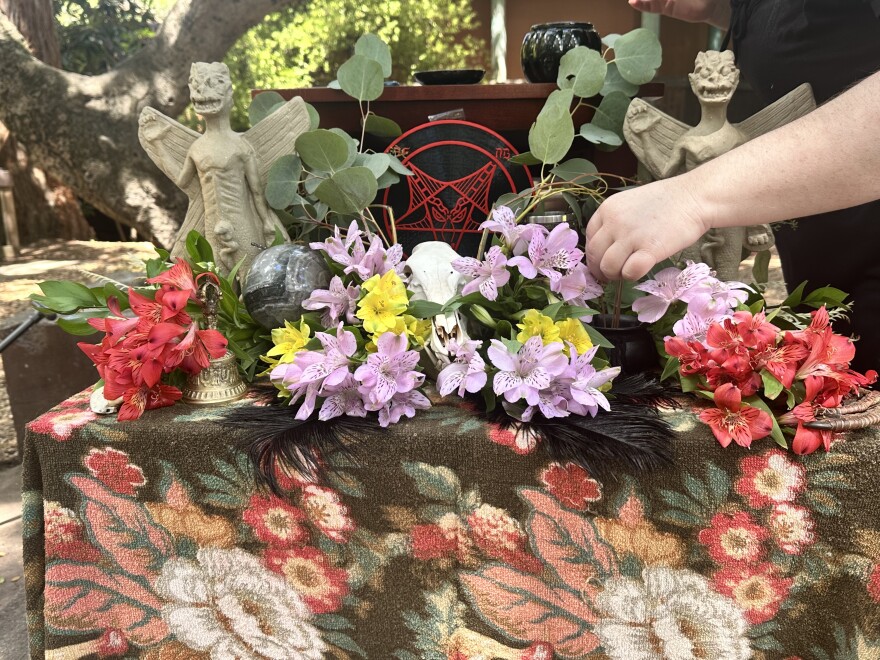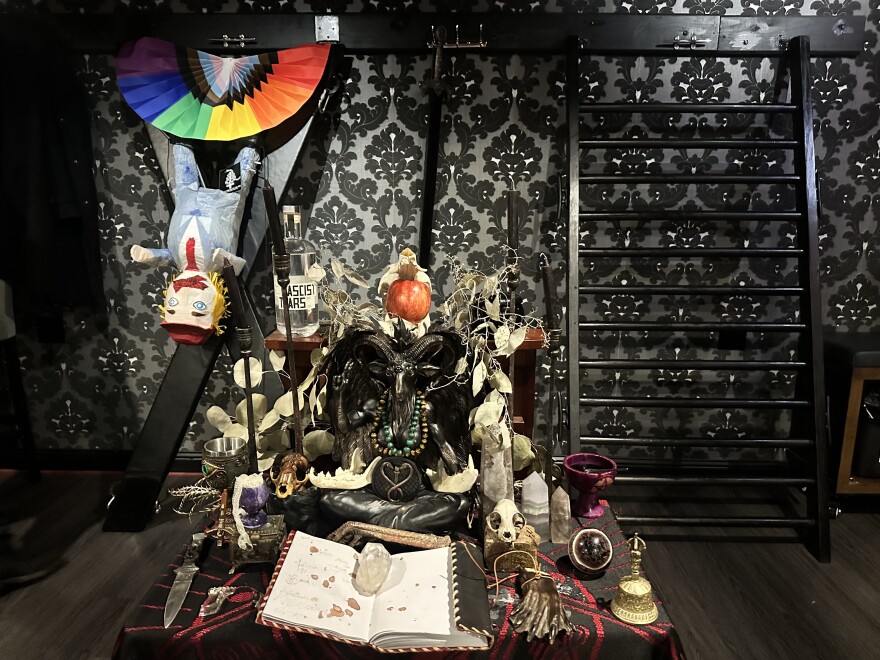This story aired in the July 23, 2025 episode of Crosscurrents.
Satanism’s modern renaissance took place right here, in Bay Area, in the 1960s, when Anton LaVey established the Church of Satan in a small, all black Victorian house in the Richmond District.
Even though LaVey and the house are no longer around — Satanists still walk the streets of San Francisco and the greater Bay Area.
In this story we go to Berkeley to talk to the Satanists that live among us.
Click the button above to listen!
Story Transcript:
REPORTER: When you imagine a Satanic Ritual, you might picture dark shadowy figures meeting under the cloak of night to sacrifice lambs and open portals to hell. But the Satanic Ritual I’m attending is taking place in the middle of a park in Berkeley, at the height of summer. Instead of animal sacrifice, there’s a table holding an assortment of snacks and beverages. Another table is overflowing with fake flowers, for flower crown making.
TABITHA SLANDER: it's just something fun for people to sit with each other and have something to do with their hands
DANIEL WALKER: Also, we might have designed this ritual right after the movie Midsommar came out. So that's possibly a creative influence on the floral imagery.
TABITHA: I also just have a problem buying very discounted, like, silk flowers.
REPORTER: These are two organizers from Satanic Bay Area — their Satanic names are: Tabitha Slander and Daniel Walker. They’re cheerful, friendly, even a little bit goofy. Not exactly who I was picturing when I was getting ready to meet Satanists this morning.
DANIEL: That is for part of the gender affirmation ritual. Last year, we used eggshells, but eggs are more expensive than pistachios and a nutshell, pretty much, communicates the same conceit.

REPORTER: They are setting up for a day of satanic rituals. This one, with the pistachio shells, is about gender affirmation. The symbolism here is around shedding the protective shells that no longer serve you and embracing your growth.
The whole day is about celebrating individuality. The group calls it Pazuzu’s Blessing — after the ancient Mesopotamian wind spirit.
DANIEL: This is the one religious holiday in the world where you get to toot your own horn and make yourself the center of attention, because pardon the expression in this context, god damn it, you matter.
REPORTER: A lot of the rituals that Satanic Bay Area organizes are heavy on aesthetics and self determination. That’s basically what they stand for.
TABITHA: For me, it's a big focus on, like, bodily autonomy, that my body is my own, and that I make my own decisions about it. It also means bucking up against arbitrary authority. And it's really kind of trying to push against kind of the religious hegemony that we are currently experiencing
REPORTER: You might be thinking - what does any of this have to do with Satan? Well — it’s all rooted in a centuries old reimagining of the religious figure.
In the Old Testament the word satan mainly showed up in the text as a word that meant “accuser” or “adversary” - someone who opposed or challenged things. The concept of Satan as more of a cosmic figure - like the The Devil we imagine - started popping up later on in the New Testament. But Satan got even more fleshed out as a character by artists and writers.
Like, In the 17th century, John Milton’s Paradise Lost transformed Satan into a righteous anti-hero, fighting against an oppressive god.
So even though you might hear the Satanists here today chant Hail Satan — it’s not because they necessarily, actually believe in worshipping the devil. Daniel jokes about this concept when he talks to the group.
"People may wonder, why do we do this? It is not because Satan told us to. Personally, Satan's never told me anything." - Daniel Walker
DANIEL: People may wonder, why do we do this? It is not because Satan told us to personally. Satan's never told me anything.
REPORTER: Satanism is a unique religion in this way. The majority of its members don’t believe in any gods.
Most of the folks I meet today are atheistic Satanists and these rituals are almost like performance art. They describe it as a way to reject conformity and practice free will. During the gender affirmation ritual, Isaiah BD takes up the altar and leads the group in an invocation.
ISAIAH BD: Every moment in which we recognize ourselves is an act of creation. We write our stories on the face of the world. They tell us you are dust, I say I am myself. Hail Satan.
CROWD: Hail Satan.
REPORTER: Even though Anton LaVey brought Satanism into mainstream, many Satanic Bay Area members don't really associate with his brand of Satanism at all. Daniel rejects it outright.
There are a lot of critiques of LaVey — particularly around his relationships with white nationalists and the way his writings romanticized fascist concepts — like ghettos. So if you show up to a Satanic Bay Area ritual, you won’t really see any of LaVey’s influence.
The group’s origin story takes place back in 2015. When a few friends who played Dungeons and Dragons together thought it might be fun to spend Halloween night doing a Satanic ritual.
DANIEL: There was some discussion about blood drinking, and it's like, well, that's one of those very consistent tropes that goes along with this. But where's the blood gonna come from? Is the safe is this hygienic?
REPORTER: Daniel ended up sourcing some food grade pigs blood from a butcher — and his friend actually made some blood cocktails from a recipe that he found online.
DANIEL: And when it was over, we were all like teenagers at the end of a first date. We're like, you know, if you wanted to do this again, sometime, I might be into that.
REPORTER: Eventually they figured… other people might be into this too and they were right. Today they have anywhere from fifty to a hundred members and conduct four to five big rituals a year.
Like… Pazuzu’s Blessing — one of their most popular events. And I can see why — there is so much joy in the air. Soon, the park’s filled with thirty people, some decked in all black, others in everyday clothes. They hug each other, pour drinks, eat fruit, and craft.
It’s clear that, more than anything, the people who come are here for community. But each person found Satanism in different ways, for different reasons.
Some Satanists - like Harq Al-Ada, who I meet by the snack table at Pazuzu’s Blessing — have never been religious.
Harq tells me that he resonated with Satanism because atheism just felt like it was missing something.
HARQ AL-ADA: Atheism is not a is not a moral stance, is not a system of values, just not it's just the absence of God. It doesn't really bring what religion brings to people, the community, you know, the values and all of that rituals.
But other Satanic Bay Area members turned to Satanism after growing up steeped in religion.
Like Didi, who tells me that she began her journey as a Satanist by performing an unbaptism on herself — a ritual where she read the Lord’s Prayer backwards and burned her baptismal certificate.
DIDI: I didn't like the fact that when I was nine and a half, I basically got coerced into doing it. In my opinion, they should not be doing that to kids. It was a chance to undo something that I felt had been done to me.
REPORTER: These days, many people are having their rights restricted, under the current administration. Which might be the reason why Daniel has been noticing more new faces in the events that Satanic Bay Area hosts.
HOPELESS: So yeah the political aspect is really big for us, the occult always being kind of, like rebellious and against anti like, anti government and anti capitalist
REPORTER: This was a newcomer I spoke to at another Satanic Bay Area event I went to, earlier this year. This one was described as a “Satanic Destruction Ritual of Personal Agency and Wrath.”
TABITHA: Who are we smashing?
PARTICIPANT: Musk!
[SMASH & CROWD CHEERS]
TABITHA: All right, yeah, just everybody keep your shoes on until they get a broom.
REPORTER: That’s the sound of someone shattering a plate scribed with Elon Musk’s name on it.
This ritual took place a month after Trump’s inauguration this year… it was one way for members of this group to do something when so much in the political landscape felt out of their control. It ended with the destruction of a Trump pinata.

TABITHA: That's a core memory right there.
REPORTER: It's kind of a dark moment. People are smashing plates and brandishing swords, there’s fake and real pig’s blood. But this is also kind of the darkest this group gets. But even amongst the despair and destruction, there’s cheering, there’s laughter, people embrace each other, and the air is electric with something that can only be born from connection.
SALA: We are broomless! We are broomless… all these witches and no brooms.
REPORTER: For the folks here, being a Satanist isn’t something they are doing to be edgy. These Satanic rituals are spaces of deep joy — places where people can be in community and celebrate themselves and each other — whether that’s by building flower crowns at a park on a sunny day or by smashing plates and howling with rage.


